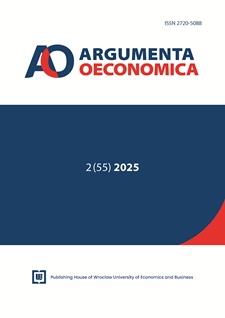Does increased trade openness enhance the impact of transport infrastructure investment on economic growth?
DOI:
https://doi.org/10.15611/aoe.2025.2.14Keywords:
transport infrastructure, investment, economic growth, trade opennessAbstract
Aim: This paper focuses on the impact of transport infrastructure investment on the economic growth of European countries, with a particular emphasis on analysing the effects of investment in both road and railway infrastructure in the first two decades of this century. The primary objective was to empirically test whether greater trade openness amplifies the positive effects of investment in transport infrastructure on economic growth.
Methodology: The panel data analysis approach was employed for its numerous advantages over timeseries or cross-section analyses, encompassing a sample of 19 European countries from 2001 to 2021. Following the results of the applied econometric tests, models were estimated using generalised least squares (GLS) and ordinary least squares with panel-corrected standard errors (PCSE) methods.
Results: The results revealed the positive impact of transport infrastructure investment on economic growth, with a pronounced significance associated with rail infrastructure investment, especially in the most developed countries. Road infrastructure investment only exhibited a positive impact in transition countries. Crucially, the analysis determined that the positive effects of investing in transport infrastructure on economic growth intensified with increasing trade openness.
Implications and recommendations: The implications of the findings suggest that transport infrastructure investment alone is insufficient to drive economic growth. Other conditions must also be satisfied, particularly the economic integration of the country. Consequently, alongside transport infrastructure investment, it is essential to foster high levels of trade openness to ensure significant positive effects on the economy. Future research should further explore the significance of additional enabling conditions, such as a well-educated workforce and improved institutional environments, in facilitating and enhancing the positive effects of transport infrastructure investment.
Originality/value: Given that the most significant investment in developing high-quality transport infrastructure within the European Union took place in the two first decades of this century, this research offers valuable insights through its empirical analysis of this period, deepening the understanding of the relationship between transport infrastructure investment and economic growth in Europe. The study’s value lies in identifying the particularly strong positive impact of investing in rail infrastructure in the most developed countries, alongside the positive influence of investing in road infrastructure, especially in transition countries where motorways comprise the largest share of investment projects. The originality of this research largely stems from its quantitative verification that increased trade openness enhances the positive effects of investing in transport infrastructure on economic growth.
Downloads
References
Aschauer, D. A. (1989). Is public expenditures productive? Journal of Monetary Economics, 23(2), 177-200. https://doi.org/10.1016/0304-3932(89)90047-0
Aschauer, D. A. (1990). Highway Capacity and Economic Growth. Economic Perspectives, 14(Sep), 14-24.
Bacovic, M. (2021). Total factor productivity growth in upper middle income Balkan countries from 2000-2017, total economy and sectoral approach: The growth accounting method. Argumenta Oeconomica, 46(1), 79-97.
Baltagi, B. (2008). Econometric Analysis of Panel Data. John Wiley & Sons Ltd.
Banister, D., & Berechman, Y. (2001). Transport investment and the promotion of economic growth. Journal of Transport Geography, 9(3), 209-218. https://doi.org/10.1016/S0966-6923(01)00013-8
Beck, N., & Katz, J. (1995). What to do (and not to do) with time-series cross-section data. American Political Science Review, 89(3), 634-647.
Boldeanu, F. T., & Constantinescu, L. (2015). The main determinants affecting economic growth. Bulletin of the Transilvania University of Braşov, Series V: Economic Sciences, 57(2), 329-338.
Broyer, S., & Gareis, J. (2013). How large is the infrastructure multiplier in the euro area? Flash Economics by Natixis Research, No. 227.
Butkus, M., Mačiulytė-Šniukienė, A., & Matuzevičiūtė, K. (2023). Transport infrastructure investments as a factor of economic growth of European Union countries. TalTech Journal of European Studies, 13(1), 150-176. https://doi.org/10.2478/bjes-2023-0008
Calderon, C., & Serven, L. (2004). The effects of infrastructure development on growth and income distribution. Working Papers Central Bank of Chile 270, Central Bank of Chile.
Cantos, P., Gumbau-Albert, M., & Maudos, J. (2005). Transport infrastructure and regional growth: Evidence of the Spanish case. MPRA Paper 15261, University Library of Munich, Germany.
Crescenzi, R., & Rodríguez-Pose A. (2012). Infrastructure and regional growth in the European Union. Papers in Regional Science, 91(3), 487-513. https://doi.org/10.1111/j.1435-5957.2012.00439.x
Crescenzi, R., Di Cataldo, M., & Rodriguez-Pose, A. (2015). Government quality and the economic returns of transport infrastructure investment in European regions. Working Papers Collection A: Public Economics, Governance and Decentralization 1508, University of Vigo, GEN – Governance and Economics Research Network.
Cuaresma, J. C., Doppelhofer, G., & Feldkircher, M. (2014). The determinants of economic growth in European regions. Regional Studies, 48(1), 44-67. https://doi.org/10.1080/00343404.2012.678824
Del Bo, C., & Florio, M. (2008). Infrastructure and growth in the European Union: an empirical analysis at the regional level in a spatial framework. Departmental Working Papers 2008-37, Department of Economics, Management and Quantitative Methods at Università degli Studi di Milano.
European Commission. (2014). Infrastructure in the EU: Development and impact on growth. European Economy Occasional Papers 203.
Eurostat. (2024). Dataset on Gross fixed capital formation by AN_F6 asset type. Retrieved October 1st, 2024 from https://doi.org/10.2908/NAMA_10_AN6
Fedderke, J., & Garlick, R. (2008). Infrastructure development and economic growth in South Africa: A review of the accumulated evidence. Policy Paper Number 12, University of Cape Town.
Forkenbrock, D. J., & Foster, N. S. J. (1990). Economic benefits of a corridor highway investment. Transportation research. Part A: General, 24(4), 303-312. https://doi.org/10.1016/0191-2607(90)90007-S
García, V. A., Meseguer, J. A., Ortiz, L. P., & Tuesta, D. (2017). Infrastructure & economic growth from a meta-analysis approach: Do all roads lead to Rome? BBVA Research Working Paper No 17/07, BBVA Bank, Economic Research Department.
Gaus, D., & Link, H. (2020). Economic effects of transportation infrastructure quantity and quality: A study of German counties. Discussion Papers of DIW Berlin 1848, DIW Berlin, German Institute for Economic Research. Greene, W. H. (2018). Econometric Analysis. Pearson.
Hooper, E., Peters, S., & Pintus, P. A. (2021). The impact of infrastructure investments on income inequality: Evidence from US states. Economics of Transition and Institutional Change, 29(2), 227-256.
Ignatov, A. (2024). European highway networks, transportation costs, and regional income. Regional Science and Urban Economics, 104 (January 2024) Article 103969. https://doi.org/10.1016/j.regsciurbeco.2023.103969
IMF. (2024). World Economic Outlook Database, April 2024 Edition. Retrieved October 1st, 2024 from https://www.imf.org/en/Publications/WEO/weo-database/2024/April/
Kam, T. C. Y. (2001). Public infrastructure spillovers and growth: Theory and time series evidence from Australia. Department of Economics Working Paper Series 811, The University of Melbourne.
Lenz, N. V., Skender, H. P., & Mirković, P. A. (2018). The impact of transport infrastructure on economic growth: Evidence from CEE. EFRI Exclusive Working Papers 2018-10, Faculty of Economics and Business, University of Rijeka.
Mohmand, T. J., Wang, A., & Saeed, A. (2017). The impact of transportation infrastructure on economic growth: Empirical evidence from Pakistan. Transportation Letters, 9(2), 63-69. https://doi.org/10.1080/19427867.2016.1165463
Moral-Benito, E. (2012). Determinants of economic growth: A Bayesian panel data approach. The Review of Economics and Statistics, 94(2), 566-579, MIT Press. https://doi.org/10.1162/REST_a_00154
Nyasha, S., & Odhiambo, N. M. (2024). Does transport infrastructure spur economic growth in South Africa? An empirical investigation. Facta Universitatis, Series: Economics and Organization, 21(2), 73-85. https://doi.org/10.22190/FUEO240405005N
OECD. (2024). ITF transport statistics – transport infrastructure investment and maintenance. Retrieved October 1st, 2024 from https://doi.org/10.1787/trsprt-data-en
OECD/ITF. (2013). Understanding the value of transport infrastructure – guidelines for macro-level measurement of spending and assets. OECD International Transport Forum.
Olejnik, A., & Olejnik, J. (2019). Increasing returns to scale, productivity and economic growth – a spatial analysis of the contemporary EU Economy. Argumenta Oeconomica, 42(1), 273-293.
Pesaran, M. H. (2007). A simple panel unit root test in the presence of cross-section dependence. Journal of Applied Econometrics, 22(2), 265-312. https://doi.org/10.1002/jae.951
Próchniak, M. (2011). Determinants of economic growth in Central and Eastern Europe: the global crisis perspective. Post-Communist Economies, 23(4), 449-468. https://doi.org/10.1080/14631377.2011.622566
Purwanto, A. J., Heyndrickx, C., Kiel, J., Betancor, O., Socorro, M. P., Hernandez, A., Eugenio-Martin, J. L., Pawlowska, B., Borkowski, P., & Fiedler, R. (2017). Impact of transport infrastructure on international competitiveness of Europe. Transportation Research Procedia, 25, 2877-2888. https://doi.org/10.1016/j.trpro.2017.05.273
Raihan, S. (2011). Infrastructure and growth and poverty in Bangladesh. MPRA Paper 37882, University Library of Munich.
Reed, W. R., & Webb, R. (2010). The PCSE estimator is good – just not as good as you think. Journal of Time-Series Econometrics, 2(1), 1-26. https://doi.org/10.2202/1941-1928.1032
Revoltella, D., Brutscher, P. B., Tsiotras, A., & Weiss, C. (2016). Infrastructure investment in Europe and international competitiveness. EIB Working Papers 2016/01, European Investment Bank.
Shi, J., Bai, T., Zhao, Z., & Tan, H. (2024). Driving economic growth through transportation infrastructure: An in-depth spatial econometric analysis. Sustainability, 16(10), 4283. https://doi.org/10.3390/su16104283
Stephan, A. (2001). Regional infrastructure policy and its impact on productivity: a comparison of Germany and France. CIG Working Papers FS IV 00-02, Wissenschaftszentrum Berlin (WZB), Research Unit: Competition and Innovation (CIG).
Straub, S., & Terada-Hagiwara, A. (2010). Infrastructure and growth in developing Asia. Asian Development Bank Economics Working Paper Series No. 231.
Sutherland, D., Araujo, S., Égert, B., & Koźluk, T. (2009). Infrastructure investment: Links to growth and the role of public policies. OECD Economics Department Working Papers 686, OECD Publishing.
Teclean, C. (2022). The impact of the quality of transport networks on economic competitiveness in the European Union. CES Working Papers, 14(2), 114-132. Centre for European Studies, Alexandru Ioan Cuza University.
Trpkova, M., & Tashevska, B. (2011). Determinants of economic growth in South-East Europe: A panel data approach. Perspectives of Innovation in Economics and Business, 7(1), 12-15.
Vinceline, P. C., Guo, S. Q., & Keeven, N. R. M. C. (2024). Analysis of the impact of transport infrastructure on economic growth in the Republic of Congo. American Journal of Industrial and Business Management, 14(10), 1288-1302. https://doi.org/10.4236/ajibm.2024.1410065
Wang, E. C. (2002). Public infrastructure and economic growth: A new approach applied to East Asian economies. Journal of Policy Modeling, 24(5), 411-435. https://doi.org/10.1016/s0161-8938(02)00123-0
World Bank. (2024). World Bank Open Data. Retrieved October 1st, 2024, from https://data.worldbank.org/
Yu, N., De Jong, M., Storm, S., & Mi., J. (2012). Transport infrastructure, spatial clusters and regional economic growth in China. Transport Reviews, 32(1), 3-28. https://doi.org/10.1080/01441647.2011.603104
Zhang, Y., & Cheng, L. (2023). The role of transport infrastructure in economic growth: Empirical evidence in the UK. Transport policy, 133, 223-233. https://doi.org/10.1016/j.tranpol.2023.01.017
Zou, W., Zhang, F., Zhuang, Z., & Song, H. (2008). Transport infrastructure, growth and poverty alleviation: Empirical analysis of China. Annals of Economics and Finance, 9(2), 345-371.
Downloads
Published
License
Copyright (c) 2025 Marko Miljković, Svetozar Tanasković, Jelica Petrović Vujačić, Ivan Vujačić

This work is licensed under a Creative Commons Attribution-ShareAlike 4.0 International License.
Accepted 2025-04-16
Published 2025-11-04








